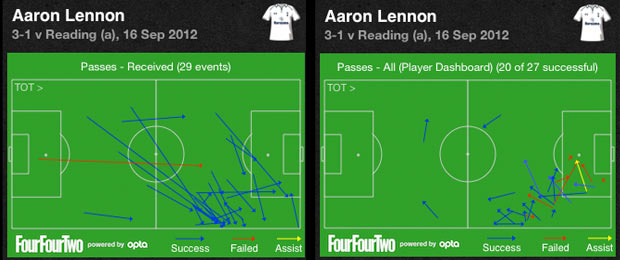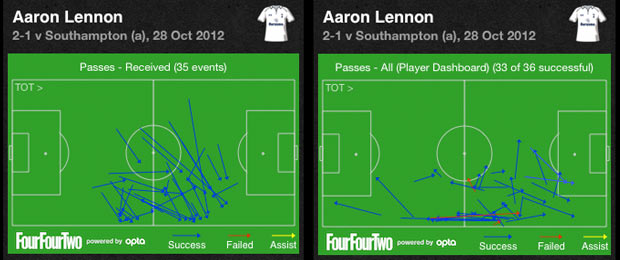Aaron Lennon had an outstanding game against Man Utd on Sunday, highlighting his return to form in recent weeks.
After a promising start to life playing for Andre Villas-Boas, Lennon struggled for a couple of months to provide either goals or assists.
In his last five matches though, the England international has scored once and laid on three others, as he has returned to the form he showed at the beginning of the campaign. So what has changed for Aaron Lennon?
Aaron Lennon early season form
Aaron Lennon hit the ground running to start the season. He was heavily involved in Jermain Defoe’s goal on opening day, then set us on our way past Reading at the Madejski by creating the opener for Defoe once more.
The diminutive winger was playing the way Andre Villas-Boas wanted. Rather than receiving the ball to feet above and outside the penalty area, he was now picking up possession through the defence and in the box.
If we look at his performance against the Royals we can see exactly this. He was still receiving the ball played out-wide before the area like he was under Harry Redknapp, but now also receives passes deeper, played through the defence. This then allowed him to cut the ball back for others or play low, driven crosses.

Aaron Lennon slows down
Lennon scored a goal and created three others in his first eight Premier League games, then came a two-month, ten-match slump.
I looked at this period back in the post ‘Aaron Lennon slowing down after a promising start.’
During this time, Lennon got away from receiving the ball in deeper positions through the defence. He reverted back to looking further back in wider areas, so that he could pick up pace and dribble at the full back like he did under Harry Redknapp.
I looked at three matches in the above post, but a typical chart for Lennon’s performances read like this one from our trip to Southampton.

He had gotten away from doing what had made him successful at the start of the season and his form suffered.
Aaron Lennon picks up the tempo again
All that changed in our Boxing Day trip to Aston Villa, where Lennon recorded an assist on Gareth Bale’s second goal.
After falling back in to old habits, Lennon was once again looking to receive the ball played deeper through the defence. He was then able to play short crosses, cut backs, or, as in the case of Bale’s goal, a short lay off in the area.

Days later, at home to Reading this time, Aaron Lennon was at it again as he crossed for Emmanuel Adebayor to head home.
Just as at the Madejski, Lennon was causing trouble by getting in behind left back Ian Harte. From here, he was able to cut the ball back, or cross it as was the case for Adebayor’s headed strike.

Role on to the Man Utd match at the weekend and our deserved draw from Lennon’s persistence.
Despite not seeing as much of the ball, he was still looking to gain possession beyond Man Utd full back Patrice Evra.
He only received 19 passes in the match, but created six chances, as he was able to square or cut the ball back from deep.

Clint Dempsey’s goal may have come after David de Gea flapped the ball in to the path of Aaron Lennon. However, credit should be given to the winger for being in such an advanced position in the penalty area which he might not have been weeks earlier. He also had the composure to cut it back for a team mate, something he has been consistently doing since the Aston Villa game.
If we look at his form over the two spells, we can see that the improvement of Aaron Lennon has returned since he has been looking to get the ball in advanced areas.
| PL Games 9-18 |
PL Games 19-23 |
|
|---|---|---|
| Mins on pitch | 891 | 447 |
| Goals | 1 | 1 |
| Assists | 1 | 3 |
| Mins per pass received | 3.8 mins | 2.8 mins |
| Mins per pass received attacking third | 8.6 mins | 5.3 mins |
| Mins per pass received in penalty area | 37 mins | 16.5 mins |
| Passes played accuracy | 83% | 86% |
| Crossing accuracy | 16% | 23% |
| Mins per chance created | 74 mins | 28 mins |
.
In his last five matches he has received the ball on average every 2.8 minutes on pitch, compared to every 3.8 minutes in Premier League matches 9-18. This is an extra 9 passes received per game, but the knock-on effect of this stat is the areas in which he receives the ball.
Prior to this five game run, he was taking possession every 8.6 minutes in the final third and every 37 minutes in the penalty area. In these last few matches, he is now gaining the ball every 5.3 minutes in the attacking third and every 16.5 minutes in the penalty area.
Gaining possession in the 18-yard box is the key to his success. At the start of the season when he was assisting on Jermain Defoe’s goals at Newcastle and Reading, he was receiving a pass in the penalty area every 19 minutes. Then from Premier League matches 9-18, he was only getting possession in the box every 37 minutes. Since he has gone on this run in his last five games, he is back to receiving the ball in the penalty area every 16.5 minutes, an even better rate.
As a result, his minutes per chance created have massively improved from one every 74 minutes to every 28 minutes.
Aaron Lennon getting the manager’s message?
Andre Villas-Boas wanted Aaron Lennon to play in a more advanced role this season than in the previous campaign for Harry Redknapp. Rather than pick up possession outside the area out on the flank and dribbling at defenders, AVB prefers to get him the ball through the defence so he can cut it back.
Lennon did well at the start of the season and seemed to be getting the manager’s message. However, after assisting on goals at Newcastle and Reading, he hit a bit of a slump, which was the result of him slipping back in to old habits.
Now he is creating opportunities again as a result of looking to get up the field and get in behind. His passes received in the final third have dramatically increased, as have his touches in the penalty area, which are key to creating short, pulled back passes. This has also improved his cross completion from 16% to 23% and the assists have followed.
With teams starting to focus more on stopping Gareth Bale recently, Aaron Lennon will need to become a bigger threat as an attacking force. The recent signs are promising.
